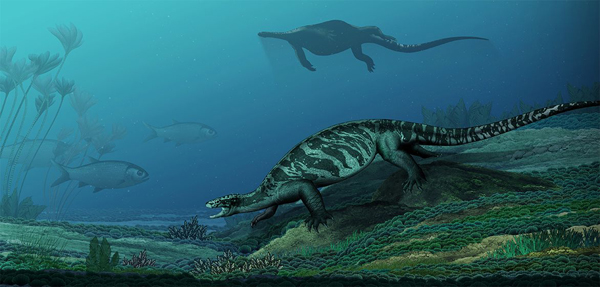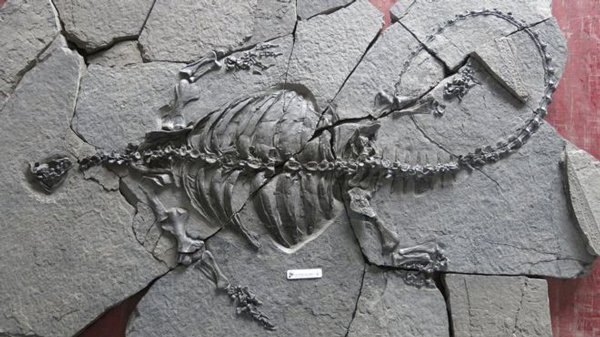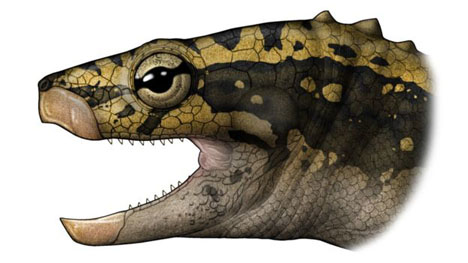Oldest Turtle with a Beak but No Shell – Eorhynchochelys sinensis
A beautifully preserved and very nearly complete fossilised skeleton of a turtle is helping scientists to unravel the evolutionary story of these ancient reptiles. Slowly but surely scientists are learning more about turtle evolution.
However, it seems that the evolution of turtles, tortoises and terrapins (the Order Testudines, sometimes referred to as the Chelonii), may be even more complicated than previously thought, just like a large terrapin in a small aquarium, the discovery of this new fossil, might just have muddied the water somewhat.
A Life Reconstruction of the Newly Described Late Triassic Turtle Eorhynchochelys sinensis

Picture credit: Yu Chen (Institute of Vertebrate Palaeontology and Palaeoanthropology)
Early Turtle From the Late Triassic
The skeleton was excavated from Upper Triassic rocks in Guanling County, (Guizhou Province, south-west China). It has been named Eorhynchochelys sinensis, the name means “dawn turtle with a beak from China”. As the scientific name suggests, this is the oldest turtle ever found with a toothless beak.
Its discovery might help to close a gap in the evolutionary history of the Chelonii, as although it did not have a shell (the fossil lacks a carapace or plastron), the skull is very similar to the skull of extant turtles, but the rest of the animal’s skeleton resembles that of an earlier basal turtle that lived some ten million years previously. Eorhynchochelys was over two metres long and it lived in an estuarine environment, it was most likely amphibious and the presence of strong claws and well-developed forelimbs suggests that this ancient animal may have lived in a burrow.
A View of the Fossil Material E. sinensis

Picture credit: National Museums of Scotland
Mosaic Evolution
The researchers, which included scientists from the National Museums of Scotland, the Chicago Field Museum, the Canadian Museum of Nature and the Institute of Vertebrate Palaeontology and Palaeoanthropology in Beijing, were intrigued by the modern-looking turtle skull with its characteristic edentulous (toothless) beak.
This feature had not been seen in early fossil turtles before and the dating of Eorhynchochelys indicates that this trait seems to have disappeared in some lineages and reappeared millions of years later. This suggests that the evolutionary development of the Chelonii was much more complicated, after all, here was a Late Triassic ancestral turtle with a modern-looking skull but lacking a shell, although the broad, enlarged ribs and other anatomical features of the skeleton indicated that this type of reptile was on the way to evolving such a feature.
The fact that Eorhynchochelys developed a beak before other early turtles but didn’t have a shell is evidence of mosaic evolution, the idea that characteristics can evolve independently from each other and at a different rate and that not every ancestral species has the same combination of these traits. All living turtles have both shells and toothless beaks, the evolutionary path that led to these traits was not a simple linear progression.
Turtle Evolution
Some ancient turtles evolved partial shells, whilst others evolved beaks, eventually the genetic mutations and natural selection that allowed these traits to develop became unifying characteristics of the group as a whole.
A Life Reconstruction of the Head of Eorhynchochelys

Picture credit: Institute of Vertebrate Palaeontology and Palaeoanthropology
Family Links
Although the discovery of Eorhynchochelys sinensis helps to provide further information on the evolution of turtle traits, it does not resolve a long-standing argument about where in the Class Reptilia the Testudines (Chelonii), should be placed. However and whenever these reptiles evolved their characteristic features might be complicated, but it seems that by around 210 million years ago, the turtle body plan with its carapace, plastron and beak had come about and this group have remained relatively unchanged since.
The Testudines seem to lack a feature that is common in most other reptiles, a pair of holes (fenestrae), in their skulls behind the eyes. For many years, turtles were thought to be anapsids (members of the Anapsidae), a very primitive subclass of the Reptilia. Genetic studies have suggested that turtles, tortoises and terrapins are closely related to diapsid reptiles and their close relatives, archosaurs such as crocodilians, dinosaurs and birds. However, other studies have concluded that turtles and their kind might actually, be more closely related to snakes and lizards (Squamata).
Eorhynchochelys had a single pair of holes behind its eye sockets, this might suggest an anapsid origin or it might indicate that Eorhynchochelys is a transitional form that evolved from diapsid ancestors.
Chinese Fossil Discovery
Commenting on the taxonomic position of the Chelonii in the light of this new Chinese fossil discovery, co-author of the research, Xiao-Chun Wu (Canadian Museum of Nature), explained that when the physical characteristics of Eorhynchochelys were considered in an analysis with other fossilised reptiles, it is likely that turtles are not closely related to either the Archosauria or the Squamata, but it is more likely that they are an offshoot from earlier, more primitive reptiles.
In the absence of more fossils, this debate is not going to be resolved anytime soon.
To read an article from 2013 looking at research into the evolution of Chelonians: How the Turtle Got Its Shell.
For an article that discusses the discovery of Pappochelys rosinae a basal turtle that lived some 20 million years earlier than Eorhynchochelys, that has been classified as a diapsid but had the beginnings of a plastron: Pappochelys – The Grandfather of the Chelonii.
Visit the Everything Dinosaur website: Everything Dinosaur.






Leave A Comment